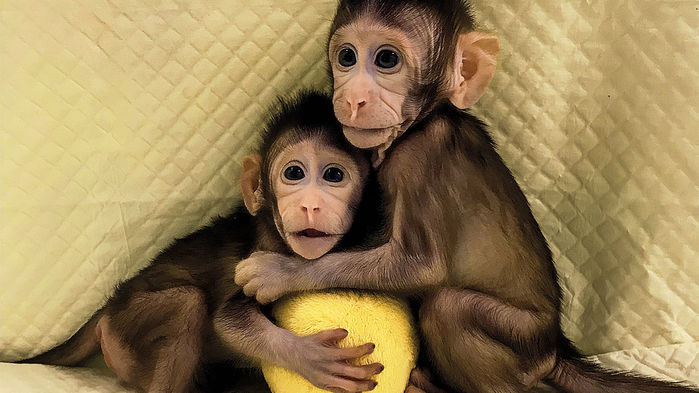Say Hello to the World’s First Cloned Monkey Twins: Zhong and Hua
We just found today that scientists from China have made two genetically identical monkey twins. They are the result of somatic cell nuclear transfer (SCNT) using the tissue from fetal monkey [1]. These newborns are named Zhong Zhongand Hua Hua. Hope they will remain healthy and survive long enough despite the low rate of success using this artificial method. Out of 21 surrogates monkey taking the SCNT embryos using fetal cells, 6 became pregnant, 2 gave live births and same 2 survived offsprings were Zhong and Hau.

SCNT is the same method that previously produced Dolly the sheep. The tricky part of using SCNT is producing embryos starting from the nucleus of a cell (+ animal egg) and allowing them to mature inside a surrogate body to fully develop into healthy animal. One needs to artificially induce an early embryonic state from an animal egg that carry foreign nucleus. In this study, researchers optimized this SCNT method particularly to create twin monkeys. However, the success rate was still very low.
Quick technical detailAccordingly to the summary of published report in the journal Cell [1], authors say
“We found that Injection of H3K9me3 demethylase Kdm4d mRNA and treatment with histone deacetylase inhibitor trichostatin A at one-cell stage following SCNT greatly improved blastocyst development and pregnancy rate of transplanted SCNT embryos in surrogate monkeys. For SCNT using fetal monkey fibroblasts, 6 pregnancies were confirmed in 21 surrogates and yielded 2 healthy babies.”
Genetic analysis was done to confirm the origin of monkey from the original donor cell and egg of monkey.
Some Interesting StatisticsIn this study, total of 63 female monkeys were used as test surrogates. Out of 63 surrogates receiving SCNT embryos, only 28 became pregnant (44.5% success rate). Out of 28 pregnancies, only 4 resulted in live births, where only 2 offspring survived. That is only a 7.1% success rate within the sample and 3.17% success rate in the whole population of 63 female monkeys used as test surrogates. In other words, the way this study was designed, the overall SCNT success rate was only 3.17%!
Ethical issuesIt would be almost impossible to do this kind of study (N = 63 total monkeys) in the U.S due to ethical issues. There are several viable alternatives to using monkeys for SCNT research. It may be simply that doing research on monkeys is easier in China and do not require stringent approval and justification. Moreover, since the SCNT embryo transferring method works on monkeys, it will likely work on humans too! Will it ever be tested on humans?
Share your thoughts.
Follow me @steem-monkey.
Welcome to Steem. Do read A thumb rule for steemit minnows - 50:100:200:25 for starter tips.
Please bookmark Steem BluePaper and Steem Whitepaper and don't miss reading when you have time.
All the Best!!!
Welcome to Steemit. I think you will like it. There are plenty of people who love talking about cryptocurrencies, but lots of other interests too. Have fun